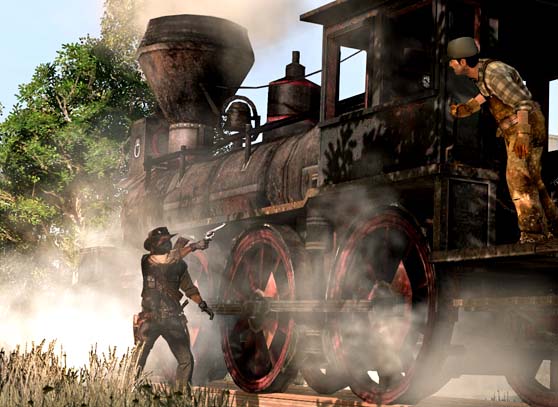

An artist's rendering of a train robbery. |
25 March 2011
Early Train Robberies Were Often Scary Events
Moose Jaw Saskatchewan - A train robbery near Moose Jaw in October 1921 was called "the
slickest heist since Old Bill Miner and his gang pulled off Canada's first train robbery at Mission Junction, British Columbia, in 1904."
CPR passenger train No. 4 had left Swift Current before dawn and was well on its way to Moose Jaw when Harry Bartle, Dominion Express messenger and sole
occupant of the express car, found himself looking into the nickel-plated barrel of a revolver.
A masked gunman ordered him to "stick up your dukes," then he was bound, gagged, tossed into a corner, and covered with an overcoat.
The safe yielded $4,000 in cash, a considerable sum in 1921, which the gunman stuffed into his pockets.
The bandit's knowledge of the route and express-car routines helped to allay suspicions. No one was aware anything was amiss when, copying the usual gesture of
express messengers, he stood in the open doorway of the express car as the train passed through Herbert and Chaplin.
Somewhere between Chaplin and Moose Jaw, the bandit jumped from the train. Some railroaders thought this was made between Chaplin and Secretan before the train
started on the fast down grade into Moose Jaw.
Others believed he waited in the express car or on the platform over the drawbars between cars until the train got to Curle junction, two miles west of Moose
Jaw station, where trains usually slowed down for the west yard.
The robbery was discovered when the express staff at Moose Jaw noticed there were no lights in the express car and heard Harry Bartle's muffled calls for help.
A full-scale search launched by the Mounted Police, provincial police, and the CPR soon turned into a continent-wide manhunt when U.S. authorities suspected
the bandit was a dangerous escapee from the penitentiary in Washington State where he was serving a long term for mail robbery and jail breaks. (The Moose Jaw
Evening Times said it knew all along the job was the work of a professional because pros carried shiny nickel-plated guns to mesmerize their victims!)
One month after the Moose Jaw robbery, the suspect was arrested in Phoenix, Arizona, while attempting to rob a Santa Fe train.
Since he was serving a 50-year sentence at the time of his escape and faced further charges in the States, Canadian police knew there was little chance of
extradition. So what was regarded as "one of the most daring train robberies ever staged in Western Canada" remained officially unsolved.
Less than two months after that train robbery, bandits struck again.
In December 1921, as the first section of an eastbound passenger train consisting of baggage, express, and mail cars, thumped over the last switch in the east
yards at Moose Jaw, a masked gunman emerged from his hiding place in the express car, fired his revolver to show he meant business, and ordered the express
manager to hand over his Colt revolver. Then he seized a sawed-off shotgun, standard equipment in railway express cars at the time, and tossed it out.
At gunpoint the messenger opened the empty safe but could not unlock the inner compartment where money was usually kept. Exasperated by the messenger's
fumblings, the would-be robber grabbed an axe from the express car's equipment box and hacked away at the compartment, lopping off its dial and handle.
When the assault failed, the bandit gave up in disgust, and knowing he had to leave the train before it reached its maximum speed, climbed down the side-door
ladder, dropped to the roadbed between the eastbound and westbound tracks, and vanished into the darkness.
The express messenger reached for the air cord, and the engineer brought the train to an abrupt stop several miles east of Pasqua. The train was backed up to
Pasqua station and news of the attempted robbery was wired to Moose Jaw and Regina.
Saskatchewan Provincial Police and CPR constables, travelling by automobile and train from both cities, converged on the spot where the bandit left the express
car. One constable rode from Moose Jaw on the cowcatcher of a locomotive to watch for any unusual movement in the broad beam of the headlight.
Over the next few days, police searched every barn, granary, chicken coop, and outhouse in the countryside without finding a clue.
Five days after the attempted robbery, a CPR section worker at Pasqua was accosted by an armed stranger. In a scuffle, the worker seized the revolver but his
attacker drew a second gun and there was a brief exchange of wide shots before the bandit fled toward the Moose Jaw River valley.
Later, at the Empress Hotel on River Street, local police arrested two shady characters suspected of being involved in the attempted railway robbery. But the
pair turned out to be hotshot gamblers with the biggest collection of gambling equipment ever seen by the local authority constabulary. When the police
released them on the attempted robbery charge, they were rearrested on a gambling charge.
During prohibition, when a lot of liquor was transported by rail across the country legally, and illegally, one freight train became the target of booze
bandits, who were thwarted by a sharp-eyed brakeman.
In 1920, a train loaded with liquor was about eight miles out of Moose Jaw when the tail-end brakeman in the caboose noticed in the moonlight, boxes strewn
along the track. When he realized someone was in one of the boxcars tossing out cargo, he stopped the train and contacted the dispatcher at Moose Jaw, who
notified the CPR and city police. The would be robber fled into the night while the police gathered up eleven cases of booze along the tracks.
Moose Jaw's train robberies of the early 1920s provided a whole new batch of railway lore for people to jaw about for decades.
Leith Knight.

|

